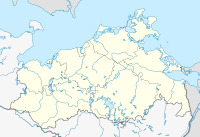Plöwensches Seebruch nature reserve
Location of the NSG in Mecklenburg-Western Pomerania |
The Plöwensches Seebruch nature reserve is a nature reserve in Mecklenburg-Western Pomerania . It is located north of the federal highway 104 between the places Löcknitz and Plöwen . With the designation on August 15, 1995, an area of 228 hectares was placed under protection. A large, contiguous reed area on the bottom of a drained lake with adjacent swamp forests and wet meadows is to be protected and developed. The nature reserve also includes the extensively cultivated meadows adjacent to the northwest and, because of the ramparts of the outer bailey of the Slavic castle ramparts Hühnerwinkel , part of the wooded area of the higher basin sand plate west of the pier.
The state of the area is rated as good. Insights into the area are possible from the road to Plöwen. In the western part there is a public path to the castle ramparts.
History and water balance
The area was decisively shaped by the Rosenthaler season and the subsequent seasons of the Vistula glaciation. After the glaciers formed a barrier further north, the areas belonged to the Haffstausee , which was created here during the final phase of the Ice Age. The slopes south of the breakwater represent the natural shoreline of the widest extent of this lagoon reservoir. The later draining water created a channel system in the basin sand sediments that were left behind. Today's Seebruch remained in such a drainage channel as a residual lake of the Haff reservoir. Later this lake gradually silted up and a fen grew up . In the 18th century, the lake area was around 50 hectares. In the 19th century, plans for lake drainage were implemented. The lake was drained via the Plöwen drainage canal towards the Randow and a large, reed-up fen was created. The desired agricultural use could only be achieved in north-western peripheral areas. Peat was also extracted there. Efforts for further drainage in the 20th century were unsuccessful.
The Slavic ramparts in the western part of the protected area indicate a settlement since the 8th century.
Flora and fauna
Reeds, swamp forests and tall herbaceous meadows are characteristic of the area. There are still many species of birds including snipe , gray goose , red-backed shrike , shrike , warbler , short-eared owl , crane , Bluethroat and Tüpfelralle . Many rare species of butterflies have been observed as dovetail , Great Purple Emperor , nasty blood droplets , Small Copper , Small Fritillary and Schachbrettfalter . The amphibian fauna is represented by the fire-bellied toad and the tree and moor frog.
literature
- Environment Ministry Mecklenburg-Western Pomerania (Ed.): Plöwensches Seebruch 303. in: The nature reserves in Mecklenburg-Western Pomerania. Demmler-Verlag, Schwerin 2003, ISBN 3-910150-52-7 , p. 402 f.
Web links
- NSG regulation
- Map portal environment of the State Office for the Environment, Nature Conservation and Geology Mecklenburg-Western Pomerania ( information ) with geodata
Individual evidence
- ↑ Burgwall Hühnerwinkel in the KLEKs with photos and map
- ↑ Plöwensches Seebruch biotope arch (PDF; 27 kB)
Coordinates: 53 ° 28 ′ 0.1 ″ N , 14 ° 15 ′ 22.1 ″ E




